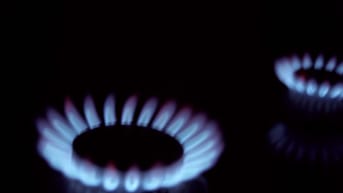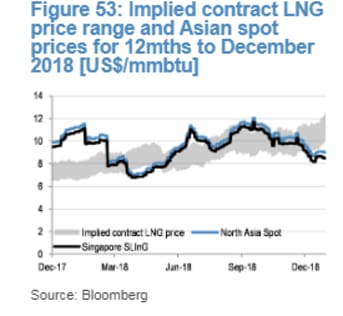After defying gloomy predictions of a supply glut and price slump in both 2017 and 2018, this year may finally see LNG markets tank, and while that's a concern for exporters, it offers some – if not much – hope of easing prices for manufacturers in the eastern states.
Spot LNG prices in Australia's key markets in Japan and Korea have already slumped by a third since September, despite the northern hemisphere winter being the peak demand period.
Credit Suisse is advising that LNG spot prices are "at risk of materially softening" this year and especially in 2020 as a flood of new LNG supply belatedly comes online.
East coast gas prices should soften but may still be unaffordable for some manufacturers. Michelle Lowings
East coast domestic prices, which have risen beyond $10 a gigajoule in spot markets in recent weeks, should see a flow-on impact, now that, as the competition regulator confirmed in December, domestic and export prices are linked together.
"Softer spot LNG prices could see a dampening effect on domestic gas prices, which is dropping from the low double digits back into the high single digits," said Credit Suisse energy analyst Saul Kavonic.
"But even then prices will still be very high by historic standards and place some manufacturers at risk with further job losses being inevitable. We won't see prices go as low as mid single digits again, those days of cheap gas are truly over."
The most recent gas report by the Australian Competition and Consumer Commission showed prices of between $9 and $10.71 a gigajoule for new supply contracts into the southern states. Some manufacturers have been paying much higher prices, with western Sydney packaging material maker RemaPak, which brought in voluntary administrators late last week, citing tariffs as high as $16/GJ.
The weaker outlook for Asian LNG prices stems from chunky additions to global supply. Global LNG production in December 2018 was about 7 per cent up year-on-year, according to JPMorgan, driven by the ramping up of production at the Yamal project in Russia as well as increasing output from Inpex's $US45 billion Ichthys project in Darwin.
More is to come with Shell yet to ship its first cargo from its Prelude floating plant in the Browse Basin, after announcing the start of production in late December.
LNG prices have been softening since September. JPMorgan
"With more supply coming online, Asian spot prices could continue to face downward pressure over the short term, despite stronger seasonal demand during the northern hemisphere winter," JPMorgan said.
Spot prices in the major market of north Asia have plunged from $US12 per million British thermal units in mid-September to just over $US8, despite northern winter usage. Market sources point to still-robust demand but plenty of new supply.
Wood Mackenzie research director Giles Farrer is predicting more LNG imports will be available than required, providing competition to pipeline gas and putting pressure on prices, but the firm is not expecting the level of oversupply that some fear. WoodMac is forecasting Asian LNG spot prices will average $US8.50 a mmBTU this year, still down about 17.5 per cent from 2018.
The weaker market is reflected in the ACCC's outlook for LNG "netback" prices in Queensland, which has markedly softened in a few months. Netback prices at the Queensland gas hub – the LNG price less gas processing and shipping costs – are now seen at $8-$10/GJ through this year and next.
But that still points to prices in double digits for industrial buyers in the south-east, including transportation and other costs.
Stephen Bell, chief executive of basic plastics maker Qenos, which has plants in Victoria and NSW, says prices quoted for gas supply in 2019 and 2020 are in the $10-$15/GJ range.
"That's not sustainable for us," he said. "Large industrials like us need gas at $6-$8."
Mr Bell says LNG import terminals, as proposed by five separate ventures in NSW, Victoria and South Australia, won't help.
"All import terminals will do is entrench LNG-linked pricing as the floor," he said, calling for more local supply to be brought online such as Santos' Narrabri gas project in NSW.
Related Quotes
- Forums
- ASX - By Stock
- STO
- Looming LNG oversupply offers slim hope for local gas buyers
Looming LNG oversupply offers slim hope for local gas buyers
-
- There are more pages in this discussion • 1 more message in this thread...
You’re viewing a single post only. To view the entire thread just sign in or Join Now (FREE)
Add STO (ASX) to my watchlist
 (20min delay) (20min delay)
|
|||||
|
Last
$6.72 |
Change
0.030(0.45%) |
Mkt cap ! $23.02B | |||
| Open | High | Low | Value | Volume |
| $6.74 | $6.77 | $6.72 | $43.42M | 6.449M |
Buyers (Bids)
| No. | Vol. | Price($) |
|---|---|---|
| 6 | 104139 | $6.72 |
Sellers (Offers)
| Price($) | Vol. | No. |
|---|---|---|
| $6.73 | 10465 | 2 |
View Market Depth
| No. | Vol. | Price($) |
|---|---|---|
| 4 | 129176 | 6.920 |
| 6 | 233123 | 6.910 |
| 9 | 295156 | 6.900 |
| 11 | 303505 | 6.890 |
| 4 | 129828 | 6.880 |
| Price($) | Vol. | No. |
|---|---|---|
| 6.940 | 107742 | 9 |
| 6.950 | 424616 | 27 |
| 6.960 | 247191 | 13 |
| 6.970 | 73167 | 4 |
| 6.980 | 17507 | 1 |
| Last trade - 16.10pm 15/11/2024 (20 minute delay) ? |
| STO (ASX) Chart |











